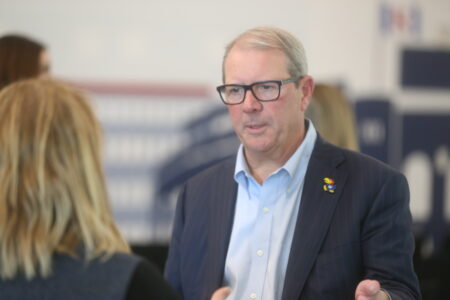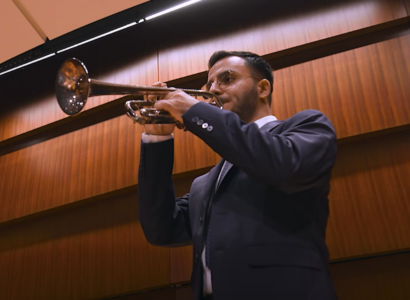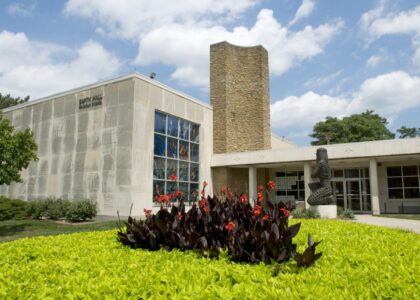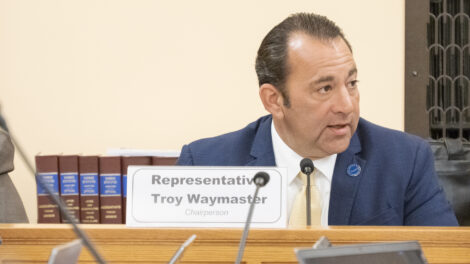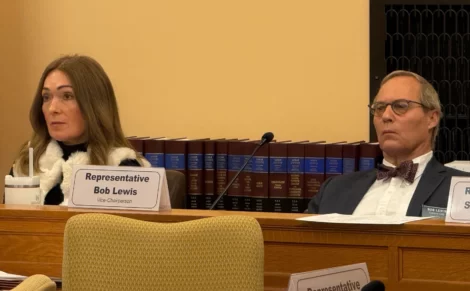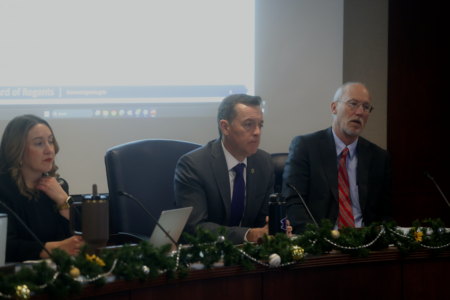KU survey didn’t ask if students wanted to return to campus; claim of ‘overwhelming’ desire to do so was based on students saying they planned on in-person classes

photo by: Conner Mitchell/Journal-World
A family works to move into Lewis Residence Hall on the University of Kansas campus on Monday, Aug. 10, 2020.
A student survey at the University of Kansas that officials have touted for weeks as evidence of students’ “overwhelming” desire to return to the Lawrence campus for an in-person fall semester did not actually ask students whether they wanted to come back amid the COVID-19 pandemic.
Eight hours after the Journal-World wrote an article Wednesday saying KU was hesitant to release the survey data, the university’s Open Records office provided the newspaper with a four-page executive summary of the survey, which was administered to the 18,851 students — 7,981 of whom responded — enrolled in classes on the Lawrence campus as of July 8.
The survey itself consisted of the following five questions, none of which asked students if they wanted to return for the fall semester:
• What the student’s living arrangement would be for the fall based on what they knew at the time (54.6% said they planned on living off campus in Lawrence)
• What the student’s comfort level was attending in-person classes (the responses to this question were not addressed in the summary nor by KU)
• What, if anything, is keeping them from being able to finalize their plans for the fall (this question was also not addressed in the summary or by KU)
• A free-response question of what KU could do to increase the student’s comfort level with in-person classes (the summary said this data was confidential)
• What the student’s attendance plans were for the fall semester.
That last question is what KU officials are claiming shows an “overwhelming” desire to return to campus. The results, though, show that only 35.7% of respondents were planning on a fully in-person schedule when the survey was administered. And an additional 42.8% of respondents said they planned on taking some courses in person and some online.
Adding those two percentages together is why KU was comfortable making the claim that students had an “overwhelming” desire to return to campus, a KU spokesperson said.
“… 78.5 percent of students said they were planning on classes that are either entirely or partially in-person – hence our suggestion that the overwhelming majority of KU students want to return to campus,” KU spokesperson Erinn Barcomb-Peterson said in an email.
KU’s analysis, though, drew criticism on Thursday.
Patrick Gauding, a Ph.D. student in KU’s political science department, analyzed the executive summary at the request of the Journal-World. Gauding’s research focuses on methodology and public policy — which often includes polls and surveys — and he has served as a teaching assistant for the statistics course that undergraduates majoring in political science are required to take.
Gauding said the survey is not structured in a way that gives KU any insight into whether students actually want to return to campus or whether they simply need to return to campus during the pandemic because they are unsure how their academic careers will progress otherwise.
“At the very least, the measures they’re using, the questions they ask don’t fully get at any bit of enthusiasm,” he said. “The responses they get are going to be a function of what classes students were intending to take in the fall.”
The fact that students are planning to attend in-person classes in the fall is different from saying they have a strong desire to do so, Gauding said. He used one of the classes he used to teach as an example. His undergraduate statistics class is required for political science majors to graduate, and therefore is always at capacity. It’s also notoriously difficult, both for the students and instructors, he said.
“If you take those registrations for the fall as a proxy for enthusiasm to be on campus, that makes no sense. If you don’t register for it, you can’t take it and you can’t graduate with a degree,” Gauding said.
“(This survey) doesn’t measure enthusiasm at all. It just measures whether you’re holding a spot in a certain class,” he said.
On July 8, when the survey was administered, KU had not completed its overhaul of courses and their delivery mode for the fall semester. That was completed on Aug. 3, and the university still has not publicly distributed a detailed breakdown of course instruction modes beyond saying around 30% of classes are in-person, 30% of classes are a hybrid of in-person and online, and 30% are online only.
During the time the survey was conducted, there was still ongoing discussion about how certain classes were going to be delivered in a remote format. For instance, it was unclear then and now how courses that are specifically hands-on — such as science labs, architecture courses, and performing arts classes, among others — were going to be effectively taught online.
Also in July following the survey’s administration, Kansas saw a dramatic spike in COVID-19 cases, Gov. Laura Kelly said the state might need to regress into a more restrictive phase of reopening, and the university’s plan to test the campus community for the respiratory virus remained unclear. Therefore, it is possible that some students said they were planning on returning for in-person classes simply because they had a fundamentally different view of how a fall semester would operate than they would if the survey were administered now.
Numerous respondents to an informal survey conducted by the Journal-World earlier this year said that they were not at all comfortable with returning to a physical semester, but a majority of those respondents indicated that despite those fears, they hadn’t considered not returning to KU or taking a semester off while the pandemic continues.
In an effort to gauge more about student opinions, and because other universities around the country have recently admitted they similarly used enrollment figures to quantify the desire for a physical semester, the Journal-World asked for the complete set of data from the survey.
But until this article KU had not publicly released any of the data. The university did not provide the full dataset, but rather said it still must estimate charges for how long it would take KU employees to anonymize the survey data.
Gauding said his experience with statistical programs is that datasets can be anonymized — making it so individuals can’t be identified — in a matter of minutes. Gauding used the same online survey software that KU frequently uses to demonstrate how quickly data could be made anonymous, and in under five minutes, there was no identifying information.
KU officials didn’t provide information on what factors would cause a delay in anonymizing the requested data.
The data that KU did provide was moderately redacted but did not cite statutes as to why it exempted sections of the email from disclosure. According to state law, not providing statutory exemptions for redactions when specifically asked to do so in the initial request — which the newspaper did — is a violation of the Kansas Open Records Act.
The survey itself was first and most prominently mentioned in a July 23 campus message from Provost Barbara Bichelmeyer’s office that broke down the estimated $120 million budget shortfall KU faces in the current fiscal year. It has been mentioned more anecdotally in update videos that Bichelmeyer and KU Chancellor Douglas Girod provide weekly to the KU community, but never with any specificity.
On July 29, shortly after Bichelmeyer’s campus message, the Journal-World filed a Kansas Open Records Act request seeking the survey data. On Aug. 3, KU responded and said it needed until Aug. 10 to further address the portion of the request seeking the survey data, which is a common practice when the Open Records office is overwhelmed with requests or personnel are away from the office and can’t immediately review records for any legal concerns.
But at 11 p.m. on Aug. 10, it said it needed another two weeks to respond, which prompted the newspaper to write an article about KU’s hesitancy in handing over the data.
After the newspaper’s story ran, the Open Records office delivered the four-page executive summary, but did not address why it didn’t disclose that document’s existence when the newspaper first asked for the data.
Lua Yuille, the president of KU’s faculty senate and a law professor, said her understanding of the survey is that it was a collaboration between the Provost Office and members of student government who would use the data to advocate for students. After the survey was complete, Yuille said Faculty Senate was given an “oral report” on the conclusions, but was never given access to the full data.
Grant Daily, KU’s student body vice president, confirmed that the KU Student Senate did collaborate with the Provost’s Office to administer the survey. Student Senate was given access to the full survey data, Daily said, but indicated that the group wasn’t entirely aware if it had the ability or authority to publicly release the data.
Nevertheless, Barcomb-Peterson appeared to lay the blame for the data not being released on those student representatives.
“As you know, this survey was developed in partnership with student governance leaders, who requested that they play a role in finalizing and distributing the survey results,” she said when asked why the survey data hadn’t been publicized earlier.
KU’s fall semester is scheduled to begin Aug. 24.
Contact Conner Mitchell
Have a story idea, news or information to share? Contact KU reporter Conner Mitchell:
- • Email: cmitchell@ljworld.com
- • Other: Tip form/Signal contact
- • Phone: 785-832-6388
- • Twitter: @ConnerMitchell0
More Lawrence Journal-World coverage of the University of Kansas


